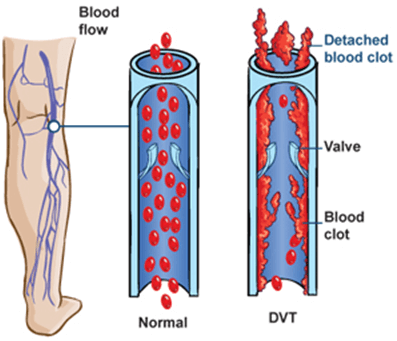DVT Full Form | What is Deep Vein Thrombosis
What is the full form of DVT
DVT: Deep Vein Thrombosis
DVT stands for Deep Vein Thrombosis. It refers to a blood clot that forms in a vein located deep inside your body, usually in the lower leg or thigh. However, it can occur in other parts of the body. Such clots are usually formed when a vein is damaged or blood flows slowly or stops flowing in a vein. It usually affects people of age 50 or more. DVT is a serious medical condition so you should consult your doctor immediately if you are experiencing symptoms of this medical condition.

Causes
The following factors can increase the risk of developing thrombosis:
- Damaged vein due to an injury such as bone fracture
- Obesity which tends to put more pressure on the veins located in the legs or pelvis
- Family history of DVT
- Use of birth control pills
- Undergoing hormone replacement therapy
- Prolonged bed rest such as during hospitalization
- Inflammatory bowel disease
- Heavy smoking
- Sitting for a longer duration such as when driving or flying for longer durations or the job of a watchman.
Common Symptoms:
- Swelling in your leg, foot, ankle usually on one side
- Cramping pain in the affected area of the leg
- Severe pain in the foot or ankle
- Redness over the affected area
- Warm sensation over the affected area
Complications:
- Pulmonary embolism: It occurs, when the blood clot breaks off and its pieces start traveling in the bloodstream and one of the pieces blocks a blood vessel that caries blood to the lung.
- Post-thrombotic syndrome: It is chronic venous insufficiency following the DVT. It occurs when the DVT damages the valves of the vein and the blood instead of moving upwards starts accumulating in your lower leg. It causes long-term pain, swelling and ulcers in some cases.
- Limb ischemia: It occurs in severe cases of DVT. In this complication, due to the blood clot, the pressure in the vein becomes very high which tends to block blood in the arteries and thus restricts oxygen supply to the affected area. It is usually painful and may cause skin ulcers and gangrene.
Diagnosis:
One the basis of symptoms if your doctor thinks that you might have a DVT, he or she may perform the following tests to diagnose DVT.
- D-Dimer: It is a blood test that is performed to detect the pieces of blood clot that travel in the bloodstream after the breakdown of the blood clot. A large number of pieces indicate the presence of blood clot in the vein.
- Doppler ultrasound: In this test, sound waves are used to monitor the blood as it flows through the blood vessels. It is suitable for identifying large blood clots above the knee.
- Venogram: In this test, a special dye is injected into the veins in the foot and then X-ray of the veins is taken to see if there is a clot in a vein. It is an ideal test to detect the blood clots below the knee.
Prevention:
- Avoid sitting or standing still for long durations
- Make positive lifestyle changes
- Regular exercise
- Avoid heavy smoking
- Maintain ideal body weight
- Maintain a healthy diet
- Increase fluid intake